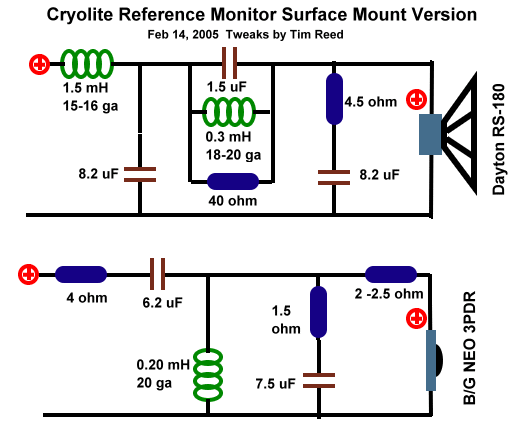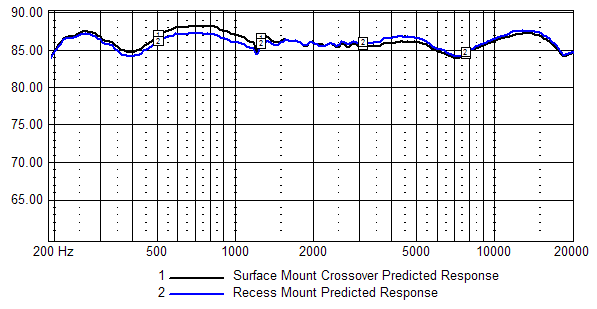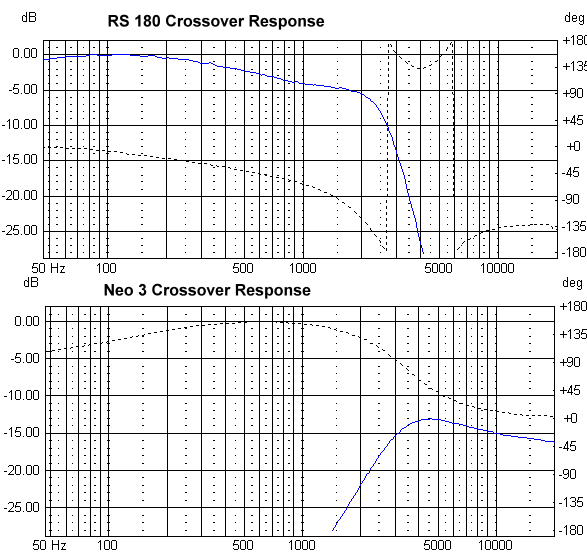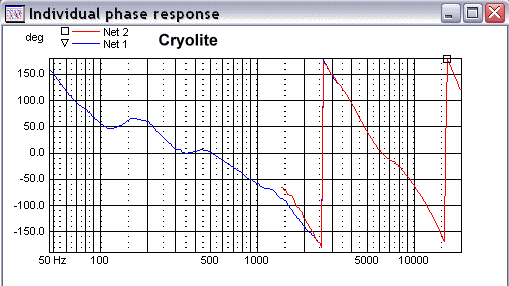Nov 28, 2004
My initial design paired the RS-180 with the Vifa D25. Due to massive operator error, I way undersized and mistuned the box. I also found that I had fried the soundcard in my shop computer. So I decided to go back to the drawing board and rethink the design.
As I played some more with my old crossover, I became convinced I could push the RS-180 out to 2400 with some treatment of the breakup modes. I also wanted to match the RS with a shielded tweeter. I decided on the the Bohlander Graebner NEO 3PDR. I've used the NEO before in the Zircon -- IMHO the best design I have done to date. I chose to use the recessed faceplate, rather than the surface mount I used on the Zircon.
Initial Crossover Design
I measured the drivers outdoors on cool windy day. I had to use a short (1 meter) square stand to keep the box from blowing over. (Too big for my tall tube stand) As I was racing the rain, I accepted a bit more ground reflection. I setup at about 1.3 meters so the Db scale is lowered. (See my measurement page for methods) I used a 30 mfd cap to protect the Neo (I should have gone to 40) The curves are a bit ragged, but adequate for design.
The crossover is a bit complicated. Pushing the RS out to 2600 required both a notch filter and a pseudo zoebel shaping circuit to contour the midrange a bit. This circuit will drop the breakup region by almost 40 dB. If you need to cheap a bit you may use 18 ga 2.0 mh coils. Those will drop the efficiency about 1 dB and require a 10 ohm padding resistor (instead of the 9). The 80 ohm bypass can be made with two 40 ohm resistors in series.
On the tweeter side, the second order is supplemented by by an RC parallel circuit that does some shaping in the 6-20 K region. I settled on the 6.8uF. You may choose a 7.3 or even an 8.2. Larger values will drop the top octave. You may also split the padding resistor. Use an 8 ohm ahead of the circuit to raise the overall impedance. Then tweak using 0.5, 1, 1.5 resistors just ahead of the Neo. I will use Mills resistors (8+1) because I think the Neo is worth the cost. (BTW, I placed a Neo ON a CRT, no effect! Very well shielded!)
I had an hour, in the garage, with my duct tape sealed prototype to tweak and listen so my impressions are based on a single channel. I liked what I heard. The Cryolite is definitely a full range monitor. The RS lives up to its promise of deep bass in a reasonable box size. Definite attack down to the 40s. As usual, I use about 3 db of baffle step as most folks will have these within 2 feet of the back wall. The aggressive notch filter reduces much of the edgy sound I heard in my first try with the driver. The NEO is simply sweet and smooth. Very revealing, nice detail, but no grit. (I can live with a hotter Neo than with most tweeters.).
DEC 1, 2004 UPDATE
I have a chance to sell a pair of Cryolites before Christmas, so I stole a bit of time to go back and do some tweaking. I liked the solid bass on the original, but I thought some vocals were a bit chesty. After about 5 passes, I came up with the crossover depicted below, I think it opens up the midrange quite a bit at the expense of a bit of baffle step correction. The phase tracking is improved as is off axis response. It's not a huge change from my original design. I feel the trade offs are well worth it. Note that I have two padding resistors, these are necessary for phase alignment. If you must tweak the padding, do so on the 6 ohm side.
Not everyone will agree with my voicing for the Cryolite. I went back to LspCad and tried to find a model that would allow some voicing changes for the Neo without altering the phase alignment of the driver. I added a shunt resistor ahead of the Neo and reduced the front end resistor to 5 ohms. Using a 30 ohm shunt resistor will duplicate the Dec 1 crossover response. Eliminating it will brighten the Neo by about 1 db. A 12 ohm will drop the neo by about 1 db. This should enable you to voice the Cryolite to your taste. Those who like things a bit on the laid back side should consider this version. The Dec 19 Crossover (Revision 2) can be found here.
Dec 30, 2004 - Remove BBC Dip
I spent some more time listening to the prototype. I decided to try tweaking the crossover a bit more and removing the BBC dip. For the most part, this required some changes in resistors and the bypass coil on the NEO. It brings vocals and brass a bit more forward. I actually preferred revision 2 for accoustic/orchestral/jazz and Revision 3 for rock/HT. The differences are really fairly subtle -- mostly moving soloists/singers a bit to the foreground. The comparison between these two can be found here.
Feb 10, 2005 - "Final" Voicing
I juggled a few parts around trying to refine the sound and enhance the imaging. I cut the padding resistors to 2 and 3 respectively. I think the break in time smoothed out the Neo. Bumping the Neo up another decibel really opened things up.
Feb 14, 2005 - Surface Mount Voicing
I have been working with another builder, Tim Reed, who chose to use the surface mount version of the Neo. We passed a few emails back and forth. Tim thought the original surface mount crossover was a bit dead. Since I came to the same conclusion on my first efforts, we worked out some revisions. We changed the resonace filter inductor, the padding scheme, and the woofer shunt. The crossover is now about 2050 with the surface mount Neo. This models very well. (Comparisons on predicted response are included below) Here are Tim's conclusions on this version.
"Much more open - better imaging - can make out more detail - words are a little clearer - seems to lift off a bit of a veil versus fist XO. And its better than any other version that I tried. Biggest key is to switch out the inductor (original .15 for the .20mH) - then next big key is to keep the 4 ohms out front of the tweeter circuit (I tried several version with lower resistance in this portion of the circuit and it didn't work as well) and adjust the resistor at the tweeter terminal down to 2 to 2.5 ohms - both sound good - I prefer 2.5. Also - the increased resistance in the woofer RC shunt seemed to help the balance - with more bass (given the increased the top end of the speaker) - for this revised version. All in all - this design is extremely good."
Feb 23, 2005 Box Design Comparison
I've been working with Russell White. He's putting together a complete HT using the Cryolites. He sent me an email with some listening impressions and an evaluation of three different box designs. He offers some improvements:
"I built my cabinets so that the front baffles could be removed by utilized #10 bolts... and blind nuts which are anchored to triangular braces at each corner in the front. The proved quite nice as I did a lot of testing and tweeking. I actually built three versions of the cabinet. 1) Sealed. 2) Rear firing round port (per your design) 3) Rear firing slot port....I did some very long listening tests. Here are my impressions of the three approaches.
1) Sealed. This is the version I have listened to the most, and it is very very good. The speaker sound the best at low volumes in this configuration. I think the most noticable difference in the lack of any unwanted high frequencies coming out the port. You can definitely tell the difference. It sharpens the soundstage and seems to clairify things a bit. I like this setup a lot, as long as you have a subwoofer to augment the low end. I will probably build a set like this for my office where I have a small subwoofer.
2) Rear firing round port. This version was the first I finished, and I have to say it is quite good, definitely better low end extension. The Bass in Nora Jones first CD really came into picture now. The was definitely not there in the sealed version. I only had one small gripe, there were audible high frequency sounds coming out the port and reflecting off the wall in back. The sound stage was not as distinct as eith er the sealed or the slot port version, and I think this is because it was muddied somewhat by high frequency sound coming out the port.
3) Rear slot port at top. This is the very best version I built IMHO. The reason is that the bass extension is as good or maybe better then the round port version (I wonder if I can I attribute this to slightly higher port volume) with the added benefit of reduced high frequencies coming out the port. This contributed to a much more precise audio image/soundstage. I think it because the port is made of 3/4 MDF and it is above the tweeter. The MDF port does not resonate as easy as a plastic/PVC port. Because it is not directly behind the tweeter there is less chance any sound will escape out the port. Also, the slot port helps stiffen and add mass to the cabinet somewhat. The slot I settled on is 7-3/8 x 8 x 1/2. It is rounded over at the leading edge and the exit as is the top of the cab at the rear.
I have
been listening to these with the rev 4 x-overs in my office now for about
30 hours. They are simply stellar. I can't wait for the xovers and additonal
neos to get hear so I can finish my set of seven for the HT. I will send
you some pics when I get home. I have not veneered them yet, but I will
soon with red oak. I can confidently say these are the best speakers I
own. Thanks for all your work. You helped my fulfill a dream! "
| Here is the design for the Surface Mounted Neo 3PDR
|
Here is a comparison of the Predicted Response from LspCad
|
| Individual
Crossover Response (Recess Mount)
Driver Phasing
|
FINAL
RECESS MOUNT CROSSOVER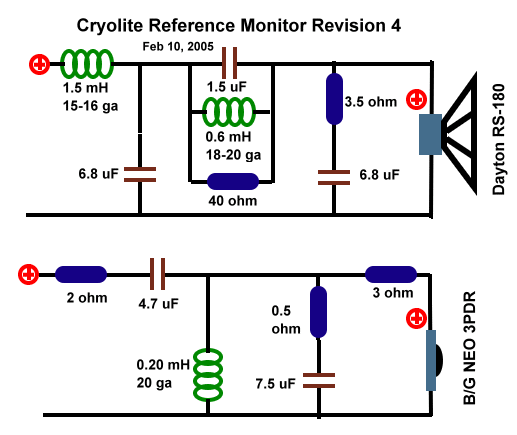 |
